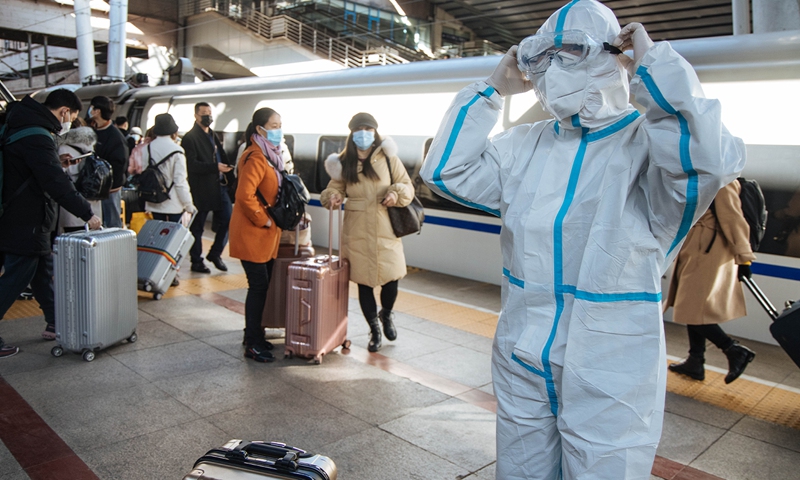Upcoming Spring Festival travel rush to recover to 90% of pre-pandemic passenger flow: China Railway

Photo:CFP
This year's Spring Festival travel rush, or chunyun as it's called in Chinese, is expected to recover to 90 percent of the passenger flow of pre-pandemic 2019, with about 360 million railway passenger trips made and the average daily number of train trips reaching about 9 million, China Railway said on Friday during a press conference introducing preparation work for chunyun.
The number represents a 42 percent increase over the chunyun in early 2022, and if it is realized, it will represent a new high since the outbreak of the pandemic in 2020, according to China Railway.
The Chinese Lunar New Year falls on January 22, 2023. The 2023 chunyun, or Spring Festival travel rush, will run from January 17 to February 25.
Whether Chinese people can return to their hometowns to reunite with their family members has been a hot topic on social media since China optimized COVID-19 response and scrapped health code and nucleic acid test checks for cross-regional travel.
Many migrant workers reached by the Global Times expressed their wish to go back to their hometowns. "I basically have recovered from COVID-19, so I'm not afraid of the infection risk or spreading the virus to other people anymore. My family also want me to go back. They never worry about me bringing back the virus," Mei, a woman who is originally from East China's Jiangsu Province and now works in Beijing, told the Global Times.
Similar to Mei, many people working in big cities have not been back to their hometowns for a family reunion since 2019.
"The slogan of not going back home for New Year and Spring Festival will be a thing of the past. We no longer need to be held back by nucleic acid testing and long quarantines. A wandering son can finally go home. I will visit my elderly parents," Dashan, who is from North China's Hebei Province and now works in Central China's Wuhan, told the Global Times.
Others are planning family trips. "This year, my family will go for a family trip to Sanya. All family members have already been infected and recovered from COVID-19," Beijing resident Tingting told the Global Times.
The recent release of 10 new COVID-19 response measures buoyed homesick individuals looking ahead to the Spring Festival holidays. On travel agency platform Tongcheng, the number of instant searches for air tickets at one point was up 438 percent from the same period the previous day, and the number of instant searches for train tickets rose by 276 percent, media reported.
Although inter-provincial travel restrictions were removed under the optimized anti-COVID measures, the first infection peak will probably come just before Spring Festival, which means that some may not go home or travel during the Chinese New Year holidays as they are still worried about becoming infected.
Inter-provincial movement and consumption will probably recover significantly in the second quarter of 2023 when the epidemic is effectively brought under control, an analyst told the Global Times on Friday on condition of anonymity.
According to China Railway, a total of 6,077 pairs of passenger trains are scheduled to operate before Spring Festival, with a passenger capacity of 9.04 million. After the holiday, 6,107 pairs of passenger trains will be arranged, with 9.14 million passenger seats. The maximum capacity is up 25 percent from the level in 2019, China Railway said.
To ensure that passengers travel safely, China Railway said that it will make epidemic prevention one of its top priorities. Waiting rooms at train stations and trains will be ventilated and completely disinfected.
The online meal booking service will cover 76 railway stations, which means the service will be available at most of the country's railway hubs and stations with large passenger flows. The number of stations where passengers can transfer without leaving the station will be increased from 80 to 100.



